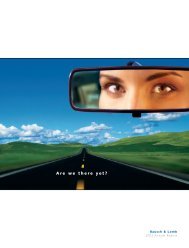You also want an ePaper? Increase the reach of your titles
YUMPU automatically turns print PDFs into web optimized ePapers that Google loves.
Notes To Financial Statements<br />
Dollar Amounts In Millions – Except Per Share Data<br />
1. Accounting Policies<br />
Principles Of Consolidation The financial statements include all<br />
majority-owned U.S. and non-U.S. subsidiaries. Intercompany<br />
accounts, transactions and profits are eliminated. The fiscal year<br />
is the 52- or 53-week period ending the last Saturday in<br />
December.<br />
Segment <strong>Report</strong>ing In accordance with Statement of Financial<br />
Accounting Standards (SFAS) No. 131, Disclosures about Segments<br />
of an Enterprise and Related Information, the company split the<br />
pharmaceuticals/surgical segment into two separate segments in<br />
<strong>1999</strong> to reflect changes in the manner in which financial information<br />
is viewed by management for decision-making purposes.<br />
The company now reports its operating results in three segments:<br />
vision care, pharmaceuticals and surgical. Prior year amounts<br />
have been restated to conform with the <strong>1999</strong> presentation.<br />
Use Of Estimates The financial statements have been prepared<br />
in conformity with generally accepted accounting principles and,<br />
as such, include amounts based on informed estimates and judgments<br />
of management with consideration given to materiality.<br />
For example, estimates are used in determining valuation<br />
allowances for uncollectible trade receivables, obsolete inventory<br />
and deferred income taxes. Actual results could differ from those<br />
estimates.<br />
Cash Equivalents Cash equivalents include time deposits and<br />
highly liquid investments with original maturities of three months<br />
or less.<br />
Inventories Inventories are valued at the lower of cost or market<br />
using the first-in, first-out (FIFO) method.<br />
Property, Plant And Equipment Property, plant and equipment,<br />
including improvements that significantly add to productive<br />
capacity or extend useful life, are recorded at cost, while maintenance<br />
and repairs are expensed as incurred. Depreciation is<br />
calculated for financial reporting purposes using the straight-line<br />
method based on the estimated useful lives of the assets as follows:<br />
buildings, 30 to 40 years; machinery and equipment, two to ten<br />
years; and leasehold improvements, the shorter of the estimated<br />
useful life or the lease periods. In accordance with SFAS<br />
No. 121, Accounting for the Impairment of Long-Lived Assets and<br />
for Long-Lived Assets to Be Disposed of, the company assesses all<br />
long-lived assets, including property, plant and equipment, for<br />
impairment whenever events or changes in circumstances indicate<br />
that the carrying amount of an asset may not be recoverable.<br />
See the future 23 <strong>Bausch</strong> & <strong>Lomb</strong><br />
Goodwill And Other Intangibles Goodwill and other intangibles<br />
are amortized on a straight-line basis over periods of up to 40 years.<br />
In accordance with SFAS 121, the company assesses intangible<br />
assets for impairment whenever events or changes in circumstances<br />
indicate that the carrying amount may not be recoverable.<br />
In completing this evaluation, the company compares its best<br />
estimate of undiscounted future cash flows, excluding interest<br />
costs, with the carrying value of the assets. If undiscounted cash<br />
flows do not exceed the recorded value, an impairment is recognized<br />
to reduce the carrying value based on the expected<br />
discounted cash flows of the business unit. Expected cash flows<br />
are discounted at a rate commensurate with the risk involved.<br />
Revenue Recognition Revenues are generally recognized when<br />
products are shipped to the customer. The company has established<br />
programs which, under specified conditions, enable<br />
customers to return product. The company establishes liabilities<br />
for estimated returns and allowances at the time of shipment. In<br />
addition, accruals for customer discounts and rebates are recorded<br />
when revenues are recognized.<br />
Advertising Expense External costs incurred in producing media<br />
advertising are expensed the first time the advertising takes place.<br />
Promotional or advertising costs associated with customer support<br />
programs are accrued when the related revenues are<br />
recognized. At December 25, <strong>1999</strong> and December 26, 1998,<br />
$3.3 and $4.0 of deferred advertising costs representing primarily<br />
production and design costs for advertising to be run in the subsequent<br />
fiscal year, were reported as other current assets.<br />
Advertising expenses for continuing operations of $181.2, $180.5<br />
and $148.8 were included in selling, administrative and general<br />
expenses for <strong>1999</strong>, 1998 and 1997, respectively.<br />
Comprehensive Income As it relates to the company, comprehensive<br />
income is defined as net earnings plus the sum of currency<br />
translation adjustments and unrealized holding gains/losses on<br />
securities (collectively “other comprehensive income”), and is presented<br />
in the Statements of Changes in Shareholders’ Equity. A<br />
change in unrealized holding gains was reported net of an income<br />
tax benefit of $11.8 in 1997.<br />
Investments In Debt And Equity Securities In 1997, certain of<br />
the company’s other investments were classified as availablefor-sale<br />
under the terms of SFAS No. 115, Accounting for Certain<br />
Investments in Debt and Equity Securities, and accordingly, unrealized<br />
holding gains and losses, net of taxes, were excluded from



